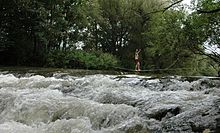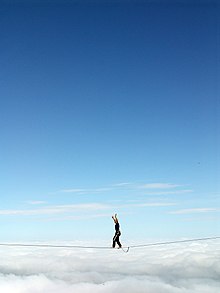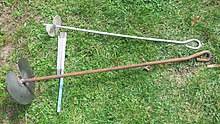Slackline
Slacken ( Slacklinen , Slacklining ) is a popular sport similar to the tightrope walking , balanced in one on a synthetic fiber band or strap which is tensioned between two fixing points. This tape is called a slackline (roughly German: slack rope, slack line).
The demands of slacking on the athlete are an interplay of balance , concentration and coordination . This makes it very suitable as additional training for sports such as climbing , skiing , martial arts , horse riding , vaulting , longboarding , snowboarding and other sports that require a good sense of balance .
Characteristic
In contrast to balancing on the dance rope or the high rope , where the rope is so tight that it hardly moves, a slackline stretches under the load of the slackliner ( slack : loose, slack, relaxed). As a result, it behaves very dynamically and requires constant active compensation of its own movement. The slackliner's balance point is therefore very low. Therefore, the visual impression resembles less the upright high wire runner or artist on the dance rope than the slack rope artist , whose rope also constantly moves under him and who balances the balance with his legs.
Although the slackliners are reluctant to be seen as artists , a certain affinity cannot be denied; only the context of the scene creates a serious difference: Slacking comes from climbing and has largely stayed there. While in artistry balancing on the slack rope usually serves as the basis or additional component for an artistic number that is to be performed in front of an audience, slackliners practice their sport more as an end in itself and for themselves. Trying to perform tricks has the main purpose to find out what is possible in this trend sport; Typical slack rope exercises such as hand and headstands , unicycling and juggling are not frowned upon in slacklining, but slackliners see themselves as an independent group.
Slackening was basically re-invented independently and the basic idea is actually nothing new.
history
While tightrope dancing has a long tradition in the circus , slacking is a very young sport.
It developed in the early 1980s from a sideline in the free-climbing scene in Yosemite National Park . Since the 1960s, they have been passing the time on days of rest and rain by balancing on cordons and cords in parking lots. Adam Grosowsky and Jeff Ellington were the first to come up with the idea of using their climbing equipment for this, and so brought slacking to the climbers' camps in the Valley, from where it spread to other climbing areas around the turn of the millennium and finally also outside of it of climbing.
In Europe, the photographer and extreme climber Heinz Zak is considered a pioneer.
Regardless of this, climbers in Europe also balanced on tense ropes in the 1970s and 1980s. In addition, ski racers Ingemar Stenmark from Sweden and Bode Miller from the United States also used a taut rope or ribbon to balance on to train their balance. However, these developments remained limited to a very small group of people and could neither prevail as a form of training nor spread as a separate sport.
species
There are currently nine types of slacklines:
Lowlines / Tricklines
The most common type of slacking is trick or lowlining, as you hardly have to worry about the structure and protection of the line. Here you try to do tricks on a relatively low, weakly stretched line (about knee to hip height above the floor, therefore lowline). It is best to choose soft ground such as grass and sand or put mats under it to prevent injuries if you lose your balance.
Some of the most popular tricks include: standing, walking, walking backwards, turning around, sitting down, lying down, "surfing", kneeling ...
Long lines
The attempt is made to cover the longest possible line from fixed point to fixed point. The difficulties here lie in several areas:
- The dead weight of the line requires very calm walking: it is difficult to get the line calm again once it has started to vibrate .
- The ability to concentrate is put to an endurance test.
- The tensioning mechanism and restraints must be set up by professionals, as large forces (up to about 100 times the weight) occur, which can lead to material failure if the wrong material or construction is used.
Rodeo and freestyle lines
Such lines are not tightly taut, but are more or less hung up "slack". Due to the slack, such lines are much more difficult to walk, and more serious falls can occur. The tricks on these lines are usually limited to walking, turning around, standing sideways and surfing, the latter more like a slow, controlled swing. Rodeo lines are good training for longlines, as in both cases the line must be kept very calm under the slackliner's center of gravity. There is also a great similarity to the slack rope here .
Highlines
Highlines are attached at a height of a few meters up to several hundred meters, so that easy and safe jumping is no longer possible. Not only does the ability to keep one's balance play a role, but especially with the very high lines there is the psychological component of walking over an abyss. Highlines are rarely used without a safety loop.
When building highlines, knowledge of the forces involved and the dimensioning of the fastenings are essential. In the event of material failure, there is not only a risk of injury, but also a risk of falling. For this reason, the fastenings for highlines are designed redundantly and the person on the line is secured to a climbing rope with a climbing harness and a safety loop attached to it, which in turn is fastened and glued under the line independently of the fastening of the actual line.
Waterlines (lines over water)


Another form of play is walking on a line stretched over water. Due to the lack of solid ground as a way to get off and as a visual fixed point, walking on such a line is usually much more difficult at the beginning than over solid ground. But after a practice phase, water lines can be used well to perform special jumping tricks, such as B. practicing the somersault without risk of injury on landing, but falling into the water is not always painless.
When choosing a place, in addition to stable fixed points, attention should be paid to a suitable bottom made of round gravel, sand or mud in order to minimize the risk of injury in the event of a fall. For normal walking, a water depth of approx. 1.40 m is sufficient, for jumps it should be much more so that the slackliner does not hit the bottom when landing. In addition, it is important to ensure that the subsurface breaks off as abruptly as possible so that the slackliner cannot injure itself due to a lack of water depth when falling near the shore. If this is not the case, other slackliners can serve as spotters, as in bouldering , or enable the climber to safely balance out of the danger zone with the help of a pole, rope, branch or similar.
There is also a difference in the inspection between standing and flowing water , as the water movement also distracts and disturbs the sense of balance. A typical effect with beginners is that the slackliner falls off the tape with the direction of flow of the water.
Inadvertently taut slacklines can pose a danger to water sports enthusiasts (boats, stand up paddlers), so when choosing a place you have to pay attention to whether the route is crossed by other athletes.
Jump lines
Another trend has been spreading since 2007, “jumping” on the slackline. There are special jump lines available on the market. In this application, the line is stretched as tightly as possible, distances of 15 m are rarely exceeded. The slackliners perform 180 ° and 360 ° turns (around the vertical axis), backflips and forward flips with landing on the slackline, flips from the line to the ground over the shoulder. Several lines are also stretched side by side and jumping from line to line. The line is partially stretched to chest height.
Night and dark lines
The slackline is set up in dark rooms or at night in the darkest possible place. The particular challenge here is that you have to rely exclusively on the organ of equilibrium, hearing and feeling the movement through the whole body. The Nightline can also be stretched as a highline (secured, of course) or a waterline. This minimizes the risk of injury from falling to the ground.
Slackline and skateboarding
This slackline movement emerged from the skateboarding scene. Skateboarders used the slacklines as a substitute for dismantled railings and benches. The skaters "grind" on the tense slacklines and then switch back to other trick elements.
Slack board
The latest type of slacklining is mainly practiced in the winter months or in bad weather. It is an indoor slackline that is attached to a construction. A slack board therefore enables slacking without the use of trees or attachment points and can also be set up in rooms.
Material and structure
Tape material
You don't necessarily need a lot of material to slacken. The most important utensil is the slackline itself. Today a flat belt with a width of 25 mm is mostly used. Sometimes 30 mm, 35 mm (beginners or therapy) or 50 mm (trick lines) wide tapes are also offered. The wider bands have a higher breaking load and much less stretch. This makes balancing much easier, as the belt can be stretched so hard that it almost doesn't sag anymore. In addition, it is easier to stabilize from the ankle on wide ligaments. This also makes walking easier at the beginning.
Above all, one must pay attention to the stretching of the tape. For lines up to 30 m in length, the more elastic bands are preferred. The movements become softer and the feeling of "slackness" is better. From 30 m, a flat belt with less stretch is often used, since otherwise the line can only be tensioned with immense effort and material expenditure.
Due to the different material properties, it is an additional challenge to learn the same tricks on tapes of different width and elasticity.
Attachment
The slackline is attached to two fixed points (e.g. trees, rocks, wall bolts ). If trees are used as fixed points, the widest possible tapes (5 cm) should be used. To protect the bark, old carpets, car mats or special cambium protectors should be placed between the bark and the belt.
There are different ways of fastening: With the former, firmly sewn lifting straps or round slings are attached to the fixed points . The line is attached to one end with a screw carabiner ( shackles are preferred because they have a higher breaking load). At the other end, either a pulley block , as is known from mountain techniques in alpinism , a tension belt ratchet or a lever hoist is used to tension the slackline . This variant is mostly used by climbers or more experienced outdoor athletes because it is a little more complicated. In the meantime there is a newer and simpler variant, whereby the set consists of only 2 parts. One part is the tape that has a loop at the end. This part is placed around the tree and the rope is threaded through the loop. The other part consists of a shorter rope that has a loop on one side and a ratchet on the other. Like the line, this part is attached to the tree. The long rope is now threaded and tightened with the ratchet. With this variant, the slackline can be set up quickly and without prior knowledge and thus makes the sport of slacklining accessible to everyone.
If trees as anchoring missing, the slackline can be guided via two columns and with a ground anchors are fixed to the ground.
Breaking load
The breaking load of all materials used is particularly important in this context . Only steel carabiners and shackles have sufficient strength to withstand all occurring loads over the long term. When using aluminum carabiners such as B. from climbing , fatigue fractures can occur. In addition, it can easily happen that the carabiners are partially loaded transversely, which greatly reduces the strength.
It is recommended not to use "normal climbing equipment, if only because of the insufficient safety reserves for longlines, highlines and jump lines".
A rule of thumb to estimate the forces at the fixed points is:
in which:
- F = force at the fixed points in kN
- L = length of the slackline in m
- D = sag of the slackline in m
- G = weight of the user in kg
With a slackline of 10 m and a sag of 0.5 m, caused by a person weighing 80 kg, this results in a load of 4 kN.
Therefore, elements of climbing equipment can be used with care for "classic slacklines (rather softly stretched) or even rodeolines (...)" if you know their weaknesses. However, you should then no longer use the materials for climbing.
Non- certified carabiners, such as those available in supermarkets and hardware stores, are usually not designed for such loads at all and represent a considerable safety risk, as the slackline is under enormous tension. Longlines sometimes have to be pretensioned with more than 15 kN so that they can be used. The equivalent of a static load of around 15 kN shows that the metal parts become real projectiles if they break. Therefore, the metal parts and the straps directly attached to them are always dimensioned larger than the slackline itself, so that only textile material is thrown around in the event of a defect.
Slack fests
Slack festivals are events where slackliners meet to tense and commit lines together, to exchange tips and tricks on structure, technique and movement or to introduce new techniques. Slack festivals are usually organized by local slackline groups or individuals, often with a suitable supporting program such as film presentations, live music, and catering. In addition, they usually also serve to present the relatively unknown sport and to increase its level of awareness.
Competitive sport
The World Slackline Federation has been trying to establish tricklining as a competitive sport since 2010 . Finally, the WSFed was founded on May 20, 2011 by slackliners. The WSFed provides certified judges who supervise the contests. Jumps and other tricks are rated according to five criteria - difficulty, technical quality of execution, variety of tricks, height of the jumps and general performance. Competitions take place at different levels.
The slackline as a training device
With the slackline, the sensorimotor system can not only be trained in an upright position. There are various positions that can be taken on the slackline, which demand the ability to balance to the utmost. Many top athletes, especially from the snow sports sector, are already training on the slackline today. The fact that skiers in particular use the slackline can be traced back to the very similar compensatory movement between this sport and slacklining.
A big advantage of the slackline compared to other training devices is that the sensorimotor skills can always be trained at the personal performance limit, as you can easily adjust the length and sag of a slackline and thus always find different conditions. Another great advantage is that most people who train slacklining have more fun than conventional balance training and can therefore be integrated into training or rehabilitation after injuries in a more sustainable manner.
literature
- Demian Geyer, Christoph Kößler: Slackline - manual for leisure, school and club. Celle 2011, ISBN 978-3-7911-0281-8 .
Web links
- http://www.slacklineinternational.org International slackline association
- Slackline Tips Encyclopaedia (Engl.)
- Topic special slackline: development, material, techniques (de.)
Individual evidence
- ↑ "A path in balance" - history of balancing from the perspective of slacking ( memento of the original from March 28, 2010 in the Internet Archive ) Info: The archive link was inserted automatically and has not yet been checked. Please check the original and archive link according to the instructions and then remove this notice.
- ^ Bode Miller's Ski Training Exercises
- ↑ Ellington pulley system for slacklines , ( detail image ) accessed on December 3, 2011.
- ↑ wkm.mw.tum.de
- ↑ a b c Miller and Friesinger: slackline. Köngen 2008.
- ↑ bergundstieg.at
- ↑ Slackline WSFed founding ( Memento of the original from June 7, 2013 in the Internet Archive ) Info: The archive link was automatically inserted and not yet checked. Please check the original and archive link according to the instructions and then remove this notice.
- ↑ World Slackline Federation: Rulebook ( Memento of the original from February 24, 2013 in the Internet Archive ) Info: The archive link was automatically inserted and not yet checked. Please check the original and archive link according to the instructions and then remove this notice. (PDF; 413 kB), as of July 2012.
- ↑ Samuel Volery, Tobias Rodenkirch: The slackline as a training device for snow sports . In: Friends of Ski Sports in the German Ski Association - Foundation Safety in Ski Sports (Ed.): FdSnow . No. 35 . Planegg 2009, p. 45–52 ( slacktivity.ch [PDF; accessed on March 10, 2016]).








